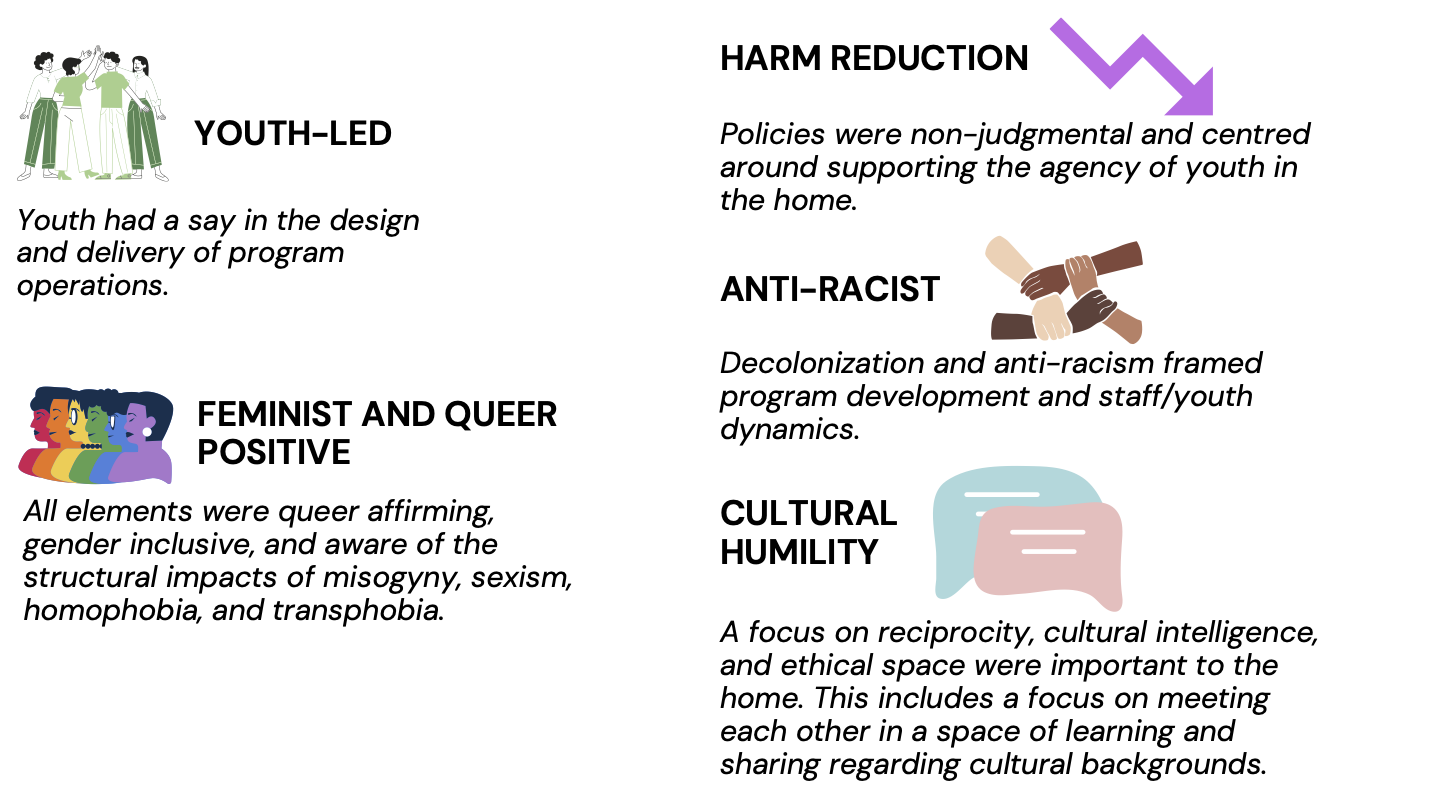Setting Goals and Outcomes
One of the first elements needed in designing your program will be establishing your overall goal or intended outcome. 'Ending homelessness' isn't specific enough and fails to provide perspective on the actual changes your program will create in the lives of 2SLGBTQ+ youth.
Creating clear housing goals/outcomes requires understanding the needs of 2SLGBTQ+ youth, including the barriers that have prevented them from having stable housing. For example, are youth being kicked out of their family homes after coming out? Are 2SLGBTQ+ youth experiencing discrimination in other group homes or from other shelters or housing agencies?
OUTSaskatoon responded directly to two concerns that were identified by 2SLGBTQ+ youth: 1. Many youth were couch-surfing because their parents/guardians were not supportive of their identity; and 2. Existing group homes in Saskatoon refused to allow all-gender residents (i.e. they were all divided along the lines of "girls home" and "boys home"). Transgender and Two Spirit youth fought to live in the homes that aligned with their gender and nonbinary and genderqueer youth had no affirming options. Because of this, an important goal for Pride Home was to provide an all-gender home where youth of diverse gender and sexual identities were able to live together.
It can be very helpful to develop short- and long-term goals in the design of your program. These can be changed as time goes on, but will help to shape programming, staffing, and even design of the home.
Example goals:
- Support youth in building life skills and capacity to life independently
- Youth complete education/gain employment
- Youth build healthy relationships and develop a support system
Additional elements that may impact your program goals:
- Focus of identified funding
- Input from youth and partners
- Needs assessment results
- Board, staff, and stakeholder feedback
Stay tuned for a smaple logic model and template
Selecting Your Housing Model
Each housing models has its own functions, strengths, and limitations. The appropriate housing type for your context will depend on the following factors:
- Youth ages - what ages of 2SLGBTQ+ youth will you support? Younger youth will require more staffing support, while older youth will require more employment counselling and training support
- Youth needs - what is the level of support that youth will need? A home that is only for trans and non-binary youth may need increased healthcare referrals, while a home for youth under 16 will need more staff than one for older youth
- Housing focus - is your home short-term, transitional, or long-term housing?
- Available funding - supported living models are more expensive than independent living models
- Available staff - you need to ensure that your staff have 2SLGBTQ+ specific knowledge. What human resources are there in your community? Can you find someone to be a live-in-mentor? Can you afford full-time or part-time staff? Do you work with an Indigiqueer or Two Spirit elder that can help support youth in the home?
- Other available housing programs in your region
Stay tuned for an interactive survey to help you determine which model might work best for you!
Types of Housing Models
This housing toolkit is designed for long-term housing programs for 2SLGBTQ+ youth, focusing primarily on a supported independent living model. However, we discuss the strengths and difficulties of this model and its variations, as well as a handful of other housing models that are used to support youth.
ffers independence and freedom for residents while still providing transitional support that includes peer support, coaching, and skills development for future fully independent living. This model does not require 24/7 staff and sometimes staff will only be onsite a couple of hours a day (depending on the ages of the residents).
Strengths:
- Facilitates relationships with other youth and staff in order to build support networks
- Provides resources and referrals for wrap-around supports such as mental health, job coaching, addictions, and mediation
- A safe and supportive place to build skills for future independent living
- Offers freedom and choice for youth
- Can be a long-term living environment which helps to stabilize youth
Difficulties:
- Not suitable for youth under 16
- Might not provide enough support to youth in crisis or those experiencing higher levels of difficulty
- Might not feel like a "group home," and could be difficult to bring various residents together for community-building or shared activities
- Might be difficult to transition youth out of the home, due to its design and function
Consists of designated apartments or units where residents live alone or with roommates. Residents are responsible for all of their own meals and cleaning and staff provide coaching and guidance, rather than housing support and management.
Strengths:
- Best for older residents (18 and up) who are looking for increased independence
- A safe environment to build and test out independent living, while still having access to direct support systems
- Could be beneficial for those youth who need a supportive community, but do not need case planning and regular support programming
- More financially feasible on the part of the organization, as costs are generally only related to staffing
Difficulties:
- Not suitable for youth under 17
- Might not provide enough support to youth in crisis or those experiencing higher levels of difficulty
- Doesn't feel like a "group home," and could be difficult to bring various residents together for community-building or shared activities
A housing model that has staff onsite 24/7 and includes a high level of supervision and oversight.
Strengths:
- Provides a safe and secure environment for youth to build relationships, learn about themselves, finish school, and build skills for future independent living
- Provides a range of programming and activities for youth, and youth are often quite involved and invested in these activities
- Builds strong relationships between youth and staff
Difficulties:
- Requires a lot of planning, scheduling, and management to ensure that staff, youth, and home are all moving cohesively
- The most expensive model as it requires 5-6 staff for one home, multiple staff roles, and additional onsite space for case planning and programming
- Requires thorough planning for youth intake, and might take longer than other models so as to ensure fit and appropriate timing
- Requires increased resources for food, supplies, transportation, and programming
- Most suitable for younger youth (15 and under), it might be frustrating for those youth that are looking for more freedom and independence
Crisis or short-term housing is used as a temporary solution to remove youth from unsafe situations. It provides a place for them to recover and to work with trained staff in finding a more long-term solution.
Strengths:
- Provides immediate housing in emergency and crisis situations (there are very few emergency shelters that are specific to 2SLGBTQ+ youth)
- Provides a knowledgeable support team to respond to acute needs and action longer-term housing
- Provides a direct access and referral point to other supports and programs
Difficulties:
- Serves as a short-term solution for larger systemic barriers
- Difficult to facilitate skills building or supportive programming that has a longer term impact
- Difficult to build relationships with youth
- Requires a high staffing complement, working in a fast-paced, crisis environment
Staffing the Home
Your staff will look different, depending on the model of your home. You will also want to take into account factors such as surrounding non-profit services, relationship to 2SLGBTQ+ specific services, youth needs, and housing design, as each of these will shift the number and types of staff that you will need.
More information regarding types of housing positions, roles, and duties can be found in the Staffing section of the toolkit.
Guiding Policies
Historically, many groups homes and other residential living facilities have relied on rules, expectations, obligations, and other formal requirements when developing their overarching practices and policies. Although strict rules are sometimes necessary, as in matters of safety and high-risk settings, 2SLGBTQ+ youth want to feel like the house they live in is a home, not an institution. We recommend finding a balance that works for you in terms of language and approach. One possibility is to change the language of rules and regulations to language focused on guiding principles and practices. This enables you to focus on the big picture principles and philosophies that will guide your practice, and using this big picture to shape some of the more specific operational policies and expectations in the home.
The guiding principles were used by OUTSaskatoon when establishing Pride Home:

- Youth-Led: Youth had a say in the design and delivery of program operations. For example, monthly programming schedules were designed collaboratively at weekly house meetings.
- Harm Reduction: Policies were non-judgmental and centred around supporting the agency of youth in the home. For example, there were no expectations of sobriety for youth living in the home. This is in contrast to some group homes where youth aren't allowed to enter if they are intoxicated
- Feminist and Queer Positive: All elements were queer affirming, gender inclusive, and aware of the structural impacts of misogyny, sexism, homophobia, and transphobia. For example, no elements of the home were divided by gender/sexuality and feminist principles were included in policy documents
- Anti-racist: Decolonization and anti-racism framed program development and staff/youth dynamics. For example, support and care were offered through a relational and familial dynamic, as opposed to institutional or strict staff versus client scenarios
- Cultural Humility: A focus on reciprocity, cultural intelligence, and ethical space were important to the home. This includes a focus on meeting each other in a space of learning and sharing regarding cultural backgrounds. For example, youth can be offered regular Two Spirit elder and participated in programming that invited all residents to learn about picking medicines and Indigenous teachings.
The guiding principles, rules, and policies that shape your program will have a direct impact on the operations and culture of your home. It is important to identify these guiding principles early on so that you can discuss them with housing partners and incoming youth.
Sometimes your guiding principles will clash with one another. When OUTSaskatoon opened in 2017, its guiding principle of harm reduction meant that it was not substance-free. Although youth could not consume alcohol or other drugs within the home, they could store substances in their own rooms and consume outside of the home. Within the first year, the residents in the home agreed that they wanted the entire home to be free of substances and their consumption, resulting in a youth-led change to an existing policy.
Policies also offer important logistical and operational frameworks such as:
- The length of time youth can stay within the home
- Rules around whether or not friends can stay over night
- Curfews and quiet times that help to respect the other residents and staff
A good policy manual is both practical and aspirational, and it is written in a clear and accessible manner that ensures that people can understand what steps to take and how to act with good common sense.
When you are building your policies, ask yourself questions such as: if we impose a 10pm curfew every night, what barriers are we creating for youth? Regarding requests for friends to sleepover, will the staff be able to navigate the situation on an ad hoc baseis according to good common sense? Or will they be better served by a clear procedure?
The following template provides a sample suite agreement that includes: house rules and guidelines and overarching policies and procedures for a queer housing program.

 Building a Foundation
Building a Foundation Designing Your Program
Designing Your Program Staffing
Staffing
 Supports & Programming
Supports & Programming Documents & Forms
Documents & Forms